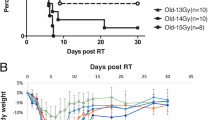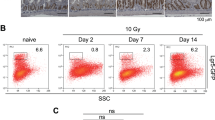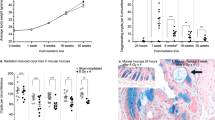Abstract
The spacial distribution of cell death among the epithelial cells lining the adult mammalian small intestinal mucosa at various times after a range of doses of 10 different drugs as well as after internal or external irradiation (beta particles from tritium, gamma- and X-rays and neutrons) has been recorded. Cell death, expressed as pycnosis or apoptosis, has been recorded for each cell position up the side of the crypts of the small intestine. The results, in the form of distributions of dead cells at each cell position, show that each of the various cytotoxic agents tends to act preferentially over a characteristic small range of cell positions. Since cell position is likely to be related to hierarchical cell position within a family tree or cell lineage, each agent tends to act with greatest efficiency on cells at a particular position within the lineage. Adriamycin and the various forms of radiation tend to kill cells preferentially at cell position 4-5 i.e. on cells very early in the lineage, probably stem cells. Isopropyl-methane-sulphonate, nitrogen mustard and possibly Actinomycin-D act on cell position 6-7, while 5-fluorouracil, Myleran, cyclophosphamide, and cycloheximide tend to kill cells at cell position 7-9. Vincristine and hydroxyurea are the 2 agents that exhibit a specificity for cells highest up the crypt, i.e. latest in transit population of the cell lineage by acting on cell positions 10 or 11. The data also suggest that normal healthy cells continue to migrate up the crypt and onto the villus in spite of considerable cell death and reduced cell production.
This is a preview of subscription content, access via your institution
Access options
Subscribe to this journal
Receive 24 print issues and online access
$259.00 per year
only $10.79 per issue
Buy this article
- Purchase on Springer Link
- Instant access to full article PDF
Prices may be subject to local taxes which are calculated during checkout
Similar content being viewed by others
Rights and permissions
About this article
Cite this article
Ijiri, K., Potten, C. Response of intestinal cells of differing topographical and hierarchical status to ten cytotoxic drugs and five sources of radiation. Br J Cancer 47, 175–185 (1983). https://doi.org/10.1038/bjc.1983.25
Issue Date:
DOI: https://doi.org/10.1038/bjc.1983.25
This article is cited by
-
Apoptosis and expression of apoptosis-related genes in mouse intestinal tissue after whole-body proton exposure
Molecular and Cellular Biochemistry (2018)
-
Mice lacking NF-κB1 exhibit marked DNA damage responses and more severe gastric pathology in response to intraperitoneal tamoxifen administration
Cell Death & Disease (2017)
-
Both the anti- and pro-apoptotic functions of villin regulate cell turnover and intestinal homeostasis
Scientific Reports (2016)
-
Alterations in Epithelial and Mesenchymal Intestinal Gene Expression During Doxorubicin-Induced Mucositis in Mice
Digestive Diseases and Sciences (2007)
-
Regional localisation of p53-independent apoptosis determines toxicity to 5-fluorouracil and pyrrolidinedithiocarbamate in the murine gut
British Journal of Cancer (2006)



